Paul Cezanne
Some people may consider the Impressionists the first of the moderns, because they defied certain rules of painting as taught in the academies. But it is well to remember that the Impressionists did not differ in their aims from the traditions of art that had developed since the discovery of nature in the Renaissance. They, too, wanted to paint nature as we see it, and their quarrel with the conservative masters was not so much over the aim as over the means of achieving it. Their exploration of colour reflexes their experiments with the effect of loose brushwork, aimed at creating an even more perfect replica of the visual impression.
It was only in Impressionism, in fact, that the conquest of nature had become complete, that everything that presented itself to the painter's eye could become the motif of a picture, and that the real world in all its aspects became a worthy object of the artist's study. Perhaps it was just this complete triumph of their methods which nude some artists hesitate to accept them. It seemed, for a moment, as if all the problems of an art aiming at the imitation of the visual impression had been solved, and as if nothing was to be gained by pursuing these aims any further.
Perhaps the first who had a clear feeling of the nature of these new problems was an artist who still belonged to the same generation as the Impressionist masters. He was Paul Cezanne (1839-1906), who was only seven years younger than Manet, and even two years older than Renoir. In his youth Cezanne took part in the Impressionist exhibitions, but was so disgusted by the reception accorded them that he withdrew to his native town of Aix-en-Provence, where he studied the problems of his art, undisturbed by the clamour of the critics.
He was a man of independent means and regular habits, and was not dependent on finding buyers for his pictures. Thus he could dedicate his whole life to the solution of the artistic problems he had set himself, and could apply the most exacting standards to his own work. Outwardly, he lived a life of tranquillity and leisure, but he was constantly engaged in a passionate struggle to achieve in his painting that ideal of artistic perfection after which he strove. He was no friend of theoretical talk, but as his fame among his few admirers grew he did sometimes try to explain to them in a few words what he wanted to do. One of his reported remarks was that he aimed at painting 'Poussin from nature'. What he wanted to say was that the old classical masters such as Poussin had achieved a wonderful balance and perfection in their work. A painting like Poussin's 'Et in Arcadia ego' presents a beautifully harmonious pattern in which one shape seems to answer the other. It feels that everything is in its place, and nothing is casual or vague. Each form stands out clearly and one can visualize it as a firm, solid body. The whole has a natural simplicity which looks restful and calm.
Cezanne aimed at an art which had something of this grandeur and serenity. But he did not think that it could be achieved any longer by the methods of Poussin. The old masters, after all, had accomplished that balance and solidity at a price. They did not feel bound to respect nature as they saw it. Their pictures are rather arrangements of forms they had learned from the study of classical antiquity. Even the impression of space and solidity was achieved through the application of firm traditional rules rather than through looking at each object anew.
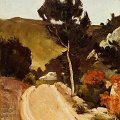 Cezanne agreed with his
friends among the Impressionists that these methods of academic art
were contrary to nature. He admired the new discoveries in the field
of colour and modelling. He, too, wanted to surrender to his
impressions, to paint the forms and colours he saw, not those he knew
about or had learned about. But he felt uneasy about the direction
painting had taken. The Impressionists were true masters in painting
'nature'. But was that really enough? Where was that striving for a
harmonious design, the achievement of solid simplicity and perfect
balance which had marked the greatest paintings of the past? The task
was to paint 'from nature', to make use of the discoveries of the
Impressionist masters, and yet to recapture the sense of order and
necessity that distinguished the art of Poussin.
Cezanne agreed with his
friends among the Impressionists that these methods of academic art
were contrary to nature. He admired the new discoveries in the field
of colour and modelling. He, too, wanted to surrender to his
impressions, to paint the forms and colours he saw, not those he knew
about or had learned about. But he felt uneasy about the direction
painting had taken. The Impressionists were true masters in painting
'nature'. But was that really enough? Where was that striving for a
harmonious design, the achievement of solid simplicity and perfect
balance which had marked the greatest paintings of the past? The task
was to paint 'from nature', to make use of the discoveries of the
Impressionist masters, and yet to recapture the sense of order and
necessity that distinguished the art of Poussin.
The dissolution of firm outlines in flickering light and the discovery of coloured shadows by the Impressionists had once again posed a new problem: how could these achievements be preserved without leading to a loss of clarity and order? To put it into simpler language: Impressionist pictures tended to be brilliant but messy. Cezanne abhorred messiness. Yet he did not want to return to the academic conventions of drawing and shading to create the illusion of solidity any more than he wanted to return to 'composed' landscapes to achieve harmonious designs. He was faced with an even more urgent issue when he pondered the right use of colour. Cezanne longed for strong, intense colours as much as he longed for lucid patterns.
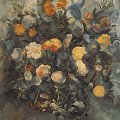 The Impressionists had given up mixing
the pigments on the palette and had applied them separately on to the
canvas in small dabs and dashes to render the flickering reflections
of an 'open-air' scene. Their pictures were much brighter in tone than
any of their predecessors but the result did not yet satisfy Cezanne.
He wanted to convey the rich and unbroken tones that belong to nature
under southern skies, but he found that a simple return to the
painting of whole areas in pure primary colours endangered the
illusion of reality. Pictures painted in this manner resemble flat
patterns and fail to give the impression of depth. Thus Cezanne
seemed to be caught up in contradictions all round. His wish to be
absolutely faithful to his sense impressions in front of nature seemed
to clash with his desire to turn - as he said - 'Impressionism into
something more solid and enduring, like the art of the museums'.
The Impressionists had given up mixing
the pigments on the palette and had applied them separately on to the
canvas in small dabs and dashes to render the flickering reflections
of an 'open-air' scene. Their pictures were much brighter in tone than
any of their predecessors but the result did not yet satisfy Cezanne.
He wanted to convey the rich and unbroken tones that belong to nature
under southern skies, but he found that a simple return to the
painting of whole areas in pure primary colours endangered the
illusion of reality. Pictures painted in this manner resemble flat
patterns and fail to give the impression of depth. Thus Cezanne
seemed to be caught up in contradictions all round. His wish to be
absolutely faithful to his sense impressions in front of nature seemed
to clash with his desire to turn - as he said - 'Impressionism into
something more solid and enduring, like the art of the museums'.
No wonder that he was often near despair that he slaved at his canvas and never ceased to experiment. The real wonder is that he succeeded, that he achieved the apparently impossible in his pictures. If art were a matter of calculation it could not have been done; but of course it is not. This balance and harmony about which artists worry so much is not the same as the balance of machines. It suddenly 'happens', and no one quite knows how or why. Much has been written about the secret of Cezanne's art. All kinds of explanations have been suggested of what he wanted and what he achieved. But these explanations remain crude; sometimes they even sound self-contradictory. But even if we get impatient with the critics, there are always the pictures to convince us. And the best advice here and always is 'go and look at the pictures in the original'.
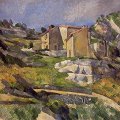 Even our
illustrations, however, should at least convey something of the
greatness of Cezanne's triumph. The landscape with Mont
Sainte-Victoire in southern France is bathed in light and yet firm and
solid. It presents a lucid pattern and yet gives the impression of
great depth and distance. There is a sense of order and repose in the
way Cezanne marked the horizontal of the viaduct and road in the
centre and the verticals of the house in the foreground, but nowhere
do we feel that it is an order which Cezanne has imposed on nature.
Even his brushstrokes are so arranged as to fall in with the main
lines of the design and to strengthen the feeling of natural
harmony.
Even our
illustrations, however, should at least convey something of the
greatness of Cezanne's triumph. The landscape with Mont
Sainte-Victoire in southern France is bathed in light and yet firm and
solid. It presents a lucid pattern and yet gives the impression of
great depth and distance. There is a sense of order and repose in the
way Cezanne marked the horizontal of the viaduct and road in the
centre and the verticals of the house in the foreground, but nowhere
do we feel that it is an order which Cezanne has imposed on nature.
Even his brushstrokes are so arranged as to fall in with the main
lines of the design and to strengthen the feeling of natural
harmony.
Admittedly there are paintings by Cezanne which are not so easily understood. In an illustration, a still life may not look too promising. How awkward it seems if we compare it with the assured treatment of a similar subject by the Dutch seventeenth-century master Kalf. The fruit-bowl is so clumsily drawn that its foot does not even rest in the middle. The table not only slopes from left to right, it also looks as if it were tilted forward. Where the Dutch master excelled in the rendering of soft and fluffy surfaces Cezanne gives us a patchwork of colour dabs which make the napkin look as if it were made of tinfoil.
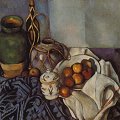 Small wonder that
Cezanne's paintings were at first derided as pathetic daubs. But the
reason for this apparent clumsiness is not far to seek. Cezanne had
ceased to take any of the traditional methods of painting for granted.
He had decided to start from scratch as it no painting had been done
before him. The Dutch master had painted his still life to display his
stupendous virtuosity. Cezanne had chosen his motifs to study some
specific problems that he wanted to solve. We know that he was
fascinated by the relation of colour to modelling. A brightly coloured
round solid such as an apple was an ideal motif to explore this
question. We know that he was interested in the achievement of a
balanced design. That is why he stretched the bowl to the left so as
to fill a void. As he wanted to study all the shapes on the table in
their relationships he simply tilted it forward to make them come into
view.
Small wonder that
Cezanne's paintings were at first derided as pathetic daubs. But the
reason for this apparent clumsiness is not far to seek. Cezanne had
ceased to take any of the traditional methods of painting for granted.
He had decided to start from scratch as it no painting had been done
before him. The Dutch master had painted his still life to display his
stupendous virtuosity. Cezanne had chosen his motifs to study some
specific problems that he wanted to solve. We know that he was
fascinated by the relation of colour to modelling. A brightly coloured
round solid such as an apple was an ideal motif to explore this
question. We know that he was interested in the achievement of a
balanced design. That is why he stretched the bowl to the left so as
to fill a void. As he wanted to study all the shapes on the table in
their relationships he simply tilted it forward to make them come into
view.
Perhaps the example shows how it happened that Cezanne became the father of 'modern art'. In his tremendous effort to achieve a sense of depth without sacrificing the brightness of colours, to achieve an orderly arrangement without sacrificing the sense of depth - in all the struggles and gropings there was one thing he was prepared to sacrifice if need be: the conventional 'correctness' of outline. He was not out to distort nature; but he did not mind very much if it became distorted in some minor detail provided this helped him to obtain the desired effect.
Brunelleschi's invention of 'linear perspective' did not interest him overmuch. He threw it overboard when he found that it hampered him in his work. After all, this scientific perspective had been invented to help painters create the illusion of space - as Masaccio had done in his fresco in St. Maria Novella. Cezanne did not aim at creating an illusion. He wanted rather to convey the feeling of solidity and depth, and he found he could do that without conventional draughtsmanship. He hardly realized that this example of indifference to 'correct drawing' would start a landslide in art.
Paul Cezanne Art
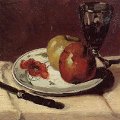
|
|
More
Articles
 Art Encyclopedia A world history of art in articles.
Art Encyclopedia A world history of art in articles.
Postimpressionism
Paul Cezanne
Life and work.
Starting the modern art.
Art
 Art Wallpapers Art image collections for your desktop.
Art Wallpapers Art image collections for your desktop.
Cezanne Art, $25
(125 pictures)
Gauguin Art, $25
(125 pictures)
Van Gogh Art, $25
(100 pictures)

